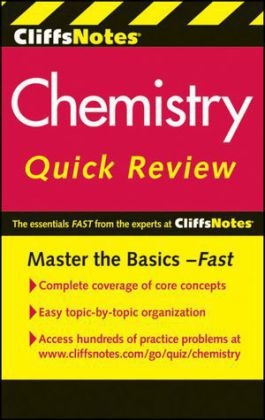Read more
Informationen zum Autor Robyn L. Ford is a classroom teacher, having taught all levels of chemistry and physics. She teaches a dual enrollment course in AP Chemistry and adjuncts at a local university. She is working toward her Ph.D. in Chemistry Education. Charles Henrickson, Ph.D., is a retired professor of Chemistry at Western Kentucky University. Klappentext Now fully updated! "CliffsNotes Chemistry Quick Review" delivers the appropriate amount of expert coverage on chemistry topics for consumers who need a supplement to a standard chemistry text! who need to prepare for exams! or who need to brush up on the fundamentals of chemistry. Zusammenfassung Inside the Book: Elements Atoms Atomic Structure Electron Configurations Chemical Bonding Organic Compounds States of Matter Gases Solutions Acids and Bases Oxidation-Reduction Reactions Electrochemistry Equilibrium Thermodynamics Review Questions Resource Center Glossary Why CliffsNotes? Go with the name you know and trust Get the information you need-fast! CliffsNotes Quick Review guides give you a clear, concise, easy-to-use review of the basics. Introducing each topic, defining key terms, and carefully walking you through sample problems, this guide helps you grasp and understand the important concepts needed to succeed. Access 500 additional practice questions at www.cliffsnotes.com/go/quiz/chemistry Master the Basics –Fast Complete coverage of core concepts Easy topic-by-topic organization Access hundreds of practice problems at www.cliffsnotes.com/go/quiz/chemistry Inhaltsverzeichnis Introduction. Why Do You Need This Book? How to Use This Book. Hundreds of Practice Questions Online! Chapter 1: Elements. Discovery and Similarity. Atomic Masses. The Periodic Table. Chapter 2: Atoms. Chemical Compounds. Stoichiometry. The Mole Unit. Chemical Reactions. Chapter 3: Atomic Structure. Subatomic Particles. Isotopes. Radioactivity. Ions. Chapter 4: Electron Configurations. Orbitals. Valence Electrons. The Periodic Table. Chapter 5: Chemical Bonding. Covalent Bonds. Ionic Bonds. Polar Bonds. Other Bonds. Chapter 6: Organic Compounds. Structural Formulas. Hydrocarbons. Compounds with Additional Elements. Chapter 7: States of Matter. Solids, Liquids, and Gases. Phase Diagrams. Heat Capacities and Transformations. Chapter 8: Gases. Boyle's Law. Charles' Law. Avogadro's Law. Ideal Gas Equation. Chapter 9: Solutions. Concentration Units. Solubility. Freezing and Boiling Points. Chapter 10: Acids and Bases. The pH Scale. Strong and Weak Acids. Two Types of Bases. Polyprotic Acids. Chapter 11: Oxidation-Reduction Reactions. Oxidation Numbers. Electron Transfer. Balancing Equations. Chapter 12: Electrochemistry. Electrochemical Cells. Electrode Potential. Faraday's Laws. Chapter 13: Equilibrium. Two Reaction Directions. Equilibrium Concentrations. Le Chatelier’s Principle. Chapter 14: Thermodynamics. Enthalpy. Energy and Entropy. Gibbs Free Energy. Review Questions. Resource Center. Books. Internet...

